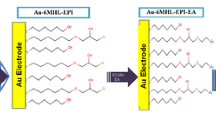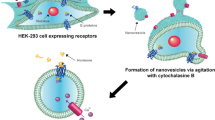Abstract
Deficiency in human growth hormone (hGH) can have a wide range of effects throughout the body. Early detection of this deficiency improves effectiveness treatment. This study investigated the fabrication of fluidic optical nanobiosensor based on reflectometric interferometry Fourier transform spectroscopy (RIFTS) to perform real-time biosensing. Initially, single-layer porous silicon (PSi) with 20–25 nm pore diameters was fabricated in two etching steps by the electrochemical method. The fluidic device was manufactured by the CO2 laser method. After integrating the PSi into the fluidic device, its performance was checked by two initial experiments measuring different concentrations of ethanol and lipid nanoparticles with diameters around 10–15 nm. To identify growth hormone, the PSi surface was modified by APTES ((3-Aminopropyl) triethoxysilane), glutaraldehyde (GA) as biochemical linkers, and then anti-growth hormone antibody (anti-hGH) as bioreporter. Linear responses to hGH in the range of 500 pg/ml-50 µg/ml in PBS buffer and in human serum were obtained. The detection limits for hGH in buffer and serum were measured as 0.38 and 0.30 ng/ml, respectively. Finally, the specificity of PSi nanobiosensor was checked by the evaluation of the response to IGg1 and BSA as blood proteins. As a result, the hGH signal was 70 times more than the signal of two non-target proteins, which indicates a high specificity of the fluidic nanobiosensor.







Similar content being viewed by others
References
J. Ayuk, M. Sheppard, Growth hormone and its disorders. Postgrad. Med. J. 82(963), 24–30 (2006)
D.W. Cooke, S.A. Divall, S. Radovick, Normal and aberrant growth in children, in Williams textbook of endocrinology. (Elsevier, 2016), pp. 964–1073
S. Stagi et al., Possible effects of an early diagnosis and treatment in patients with growth hormone deficiency: the state of art. Ital. J. Pediatr. 43(1), 1–9 (2017)
V. Gupta, Adult growth hormone deficiency. Ind. J. Endocrinol. Metabol. 15(Suppl3), S197 (2011)
S.D.M. Keizer-Schrama, Growth hormone deficiency: Etiology, pathology, science and diagnosis. Ind. J. Pediat. 58(5), 11–16 (1991)
J.-C. Job, Early diagnosis and early treatment of growth hormone deficiency. Hormone Res. Paediat. 31(4), 149–152 (1989)
W. Jung et al., Point-of-care testing (POCT) diagnostic systems using microfluidic lab-on-a-chip technologies. Microelectron. Eng. 132, 46–57 (2015)
J. Svitel, J. Katrl, Optical biosensors. Essays. Biochem. 60, 91–100 (2016)
S.M. Yoo, S.Y. Lee, Optical biosensors for the detection of pathogenic microorganisms. Trends. Biotechnol. 34(1), 7–25 (2016)
R. Peltomaa et al., Optical biosensors for label-free detection of small molecules. Sensors 18(12), 4126 (2018)
C.A. Betty, Porous silicon: a resourceful material for nanotechnology. Recent Pat. Nanotechnol. 2(2), 128–136 (2008)
T. Tieu et al., Advances in porous silicon–based nanomaterials for diagnostic and therapeutic applications. Adv. Therapeutics 2(1), 1800095 (2019)
R. Moretta et al., Porous silicon optical devices: recent advances in biosensing applications. Sensors 21(4), 1336 (2021)
T.F. Paes et al., Simple method for measuring the porosity, thickness and refractive index of porous silicon, based on the Fabry-Pérot interference spectrum. Revista Brasileira de Aplicações de Vácuo 35(3), 117–122 (2017)
M.J. Sailor, Porous silicon in practice: preparation, characterization and applications (John Wiley & Sons, USA, 2012)
C. Li et al., New concepts of integrated photonic biosensors based on porous silicon, in Biosensors-Emerging Materials and Applications (IntechOpen, USA, 2011)
N. Khansili, G. Rattu, P.M. Krishna, Label-free optical biosensors for food and biological sensor applications. Sens. Actuat, B Chem. 265, 35–49 (2018)
F. Makiyan et al., Label-free discrimination of single nucleotide changes in DNA by reflectometric interference Fourier transform spectroscopy. Colloids Surf., B 181, 714–720 (2019)
M. Yaghoubi et al., A lectin-coupled porous silicon-based biosensor: label-free optical detection of bacteria in a real-time mode. Sci. Rep. 10(1), 1–12 (2020)
F. Rahimi et al., Optimization of porous silicon conditions for DNA-based biosensing via reflectometric interference spectroscopy. Cell. J. (Yakhteh) 20(4), 584 (2019)
R. Caroselli et al., Real-time and in-flow sensing using a high sensitivity porous silicon microcavity-based sensor. Sensors 17(12), 2813 (2017)
G. Luka et al., Microfluidics integrated biosensors: a leading technology towards lab-on-a-chip and sensing applications. Sensors 15(12), 30011–30031 (2015)
Y.-T. Chen et al., Review of integrated optical biosensors for point-of-care applications. Biosensors 10(12), 209 (2020)
J. Wang et al., Silicon-based integrated label-free optofluidic biosensors: latest advances and roadmap. Adv. Mater. Technol. 5(6), 1901138 (2020)
J.-Y. Cheng et al., Direct-write laser micromachining and universal surface modification of PMMA for device development. Sens. Actuat, B Chem. 99(1), 186–196 (2004)
T.-F. Hong et al., Rapid prototyping of PMMA microfluidic chips utilizing a CO 2 laser. Microfluid. Nanofluid. 9(6), 1125–1133 (2010)
H. Klank, J.P. Kutter, O. Geschke, CO 2-laser micromachining and back-end processing for rapid production of PMMA-based microfluidic systems. Lab Chip 2(4), 242–246 (2002)
A.B. González-Guerrero et al., Direct and label-free detection of the human growth hormone in urine by an ultrasensitive bimodal waveguide biosensor. J. Biophotonics 10(1), 61–67 (2017)
M.R. Gasco, Method for producing solid lipid microspheres having a narrow size distribution. Google Patents 5, 250–236 (1993)
A.Z. Tasic, B.D. Diordjevic, D.K. Grozdanic, N. Radojkovic, Use of mixing rules in predicting refractive indices and specific refractivities for some binary liquid mixtures. J. Chem. Eng. Data 37, 310–313 (1992)
Author information
Authors and Affiliations
Corresponding author
Ethics declarations
Conflict Of Interest
The authors declare no conflicting financial interest.
Additional information
Publisher's Note
Springer Nature remains neutral with regard to jurisdictional claims in published maps and institutional affiliations.
Rights and permissions
About this article
Cite this article
Ghiasi Tarzi, M., Rahimi, F., Abouei Mehrizi, A. et al. Real-time biosensing of growth hormone on porous silicon by reflectometric interference Fourier transform spectroscopy. Appl. Phys. A 128, 64 (2022). https://doi.org/10.1007/s00339-021-05208-y
Received:
Accepted:
Published:
DOI: https://doi.org/10.1007/s00339-021-05208-y




